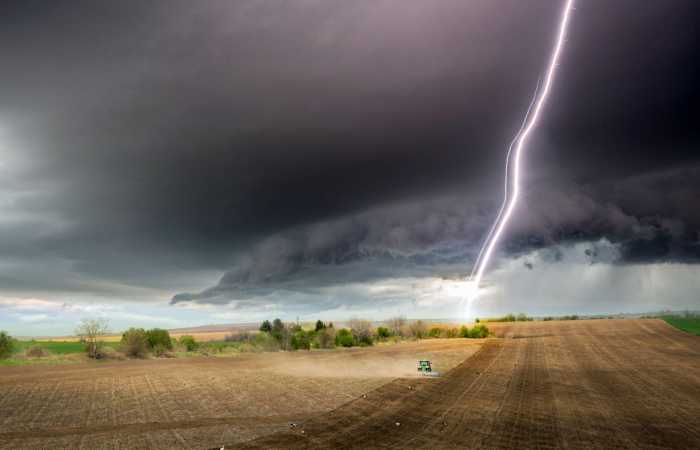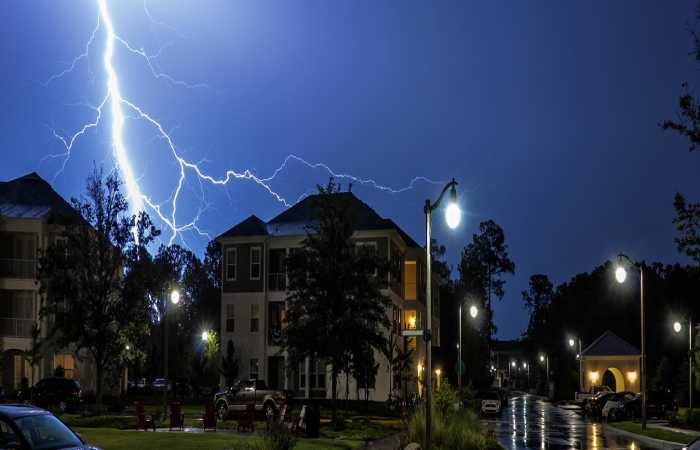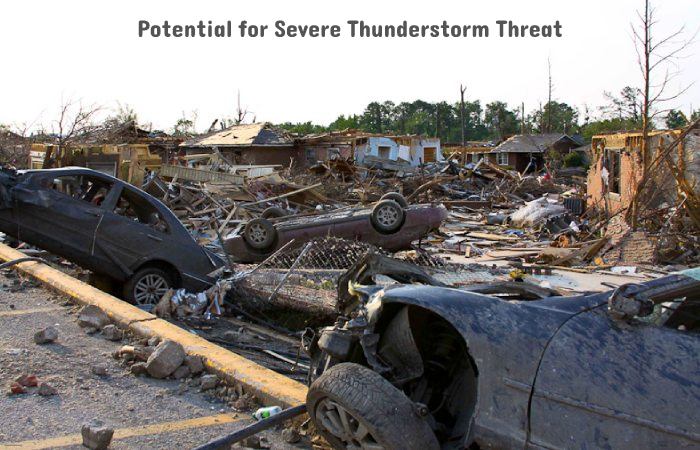Table of Contents
Introduction
Amenaza De Tormenta Eléctrica Intensa – An intense electrical storm presents a formidable natural threat that can have significant and widespread consequences. Thunderstorms, capable of generating intense lightning, heavy rainfall, strong winds, and even hail, can quickly escalate into a dangerous and disruptive situation. This threat is not limited to a particular geographical region; it can occur in various parts of the world, causing disruption to daily life and posing risks to people, property, and infrastructure.
Intense electrical storms have the potential to lead to power outages, fires, flash floods, and structural damage, making them a matter of grave concern for both individuals and communities. Furthermore, lightning strikes can result in injuries and fatalities, making it crucial to take precautions during such storms.
Understanding the characteristics, warning signs, and safety measures associated with intense electrical storms is essential for public safety and disaster preparedness. This article will delve into the subtleties of these storms, their causes, and impacts, and guide how to stay safe when faced with the menacing threat of an intense electrical storm.
What Defines a Amenaza De Tormenta Eléctrica Intensa?
An “Amenaza de Tormenta Eléctrica Intensa” is defined by severe thunderstorms exhibiting specific characteristics. These storms typically feature frequent lightning strikes, often in continuous or intense electrical discharges. They also bring heavy rainfall strong winds, and may produce hail.
Intense electrical storms can potentially cause significant damage, including power outages, flash floods, fires, and structural destruction. Lightning poses a severe risk to individuals, and these storms may lead to injuries or fatalities. The severity of an intense electrical storm is characterized by the combination of these elements, making it a substantial and immediate threat to public safety and well-being.
What is a Severe Thunderstorm?
A severe thunderstorm is a powerful and potentially dangerous weather phenomenon characterized by specific criteria. It typically includes intense lightning, heavy rainfall, strong winds beyond 58 miles per hour (93 kilometers per hour), and hail with a diameter of at least 1 inch (2.5 centimeters). These storms can lead to various hazards, such as flash floods, power outages, and structural damage.
Severe thunderstorms may also produce tornadoes, further increasing their potential for destruction. Meteorological agencies issue warnings and advisories when these conditions are expected, helping people prepare & take necessary precautions to mitigate the risks associated with severe thunderstorms.

Origins of Severe Thunderstorm Threat
The origins of a severe thunderstorm threat can be traced to specific atmospheric conditions. These storms typically develop when warm, moist air near the surface rises and collides with cooler, drier air aloft. This collision creates instability in the atmosphere, leading to the rapid upward drive of warm, moist air, which can condense into towering cumulonimbus clouds.
Within these clouds, updrafts and downdrafts, fueled by wind shear, can lead to the development of hail, heavy rainfall, and frequent lightning. This combination of factors results in severe thunderstorms, which can pose significant risks, from damaging winds and rain to flash floods and even tornadoes.
Safety Precautions for Severe Thunderstorm Threat
When facing a severe thunderstorm threat, taking safety precautions is crucial:
-
- Stay Informed: Monitor weather alerts and warnings from local authorities or weather services.
- Seek Shelter: Move indoors to a sturdy building, away from windows and doors, to protect against lightning and hail.
- Avoid Water: Stay away from bodies of water and avoid using electrical appliances during the storm.
- Stay Tuned: Keep a battery-powered weather radio or a smartphone with alerts enabled to receive updates.
- Prepare an Emergency Kit: Have essentials like flashlights, batteries, first-aid supplies, and non-perishable food on hand.
Consequences of Intense Thunderstorms
Intense thunderstorms can bring about a range of significant results:
- Flooding: Heavy rainfall can lead to flash floods, causing property damage and endangering lives.
- Lightning Strikes: Frequent lightning poses a risk of fires, injuries, and fatalities.
- Hail Damage: Large hail can damage vehicles, roofs, and crops.
- Strong Winds: Severe gusts may lead to power outages, uprooted trees, and structural damage.
- Tornadoes: Some intense storms can spawn tornadoes, causing extensive destruction and danger.
- Economic Impact: The damage to property and infrastructure can result in substantial financial losses.
- Disruption: Storm-related issues, including transportation and emergency services, can disrupt daily life.

Potential for Severe Thunderstorm Threat
The potential for a severe thunderstorm threat depends on specific atmospheric conditions. The key ingredients are high instability, moisture, wind shear, and a trigger mechanism. Warm, moist air near the surface rising and colliding with cooler, drier air can create instability. Wind shear, the alteration in breeze speed and direction with height helps form rotating updrafts, which is essential for hail and tornadoes. A trigger, like a cold front or a dry line, initiates storm development. Monitoring weather forecasts and understanding these conditions is crucial for predicting the potential for severe thunderstorms. When these factors align, the risk of severe thunderstorms with damaging winds, hail, and tornadoes increases.

Factors Contributing to Intense Electrical Storms
Intense electrical storms, also known as thunderstorms, are primarily fuel by the convergence of several key factors. Warm, moist air at the surface rises and collides with more excellent, drier air aloft, creating atmospheric instability. This uplift, aided by wind patterns, forms towering cumulonimbus clouds. Strong updrafts and downdrafts within these clouds lead to the development of lightning, heavy rainfall, and hail. Additionally, wind shear, variations in wind speed and direction with altitude, can contribute to storm organization and severity, potentially leading to tornadic activity. These factors, when combined, create the perfect conditions for intense electrical storms with their associated hazards.
Amenaza de Tormenta Eléctrica Intensa – YouTube
Conclusion
In conclusion, intense electrical storms, commonly called thunderstorms, are natural phenomena driven by a complex interplay of atmospheric factors. These storms, characterized by severe lightning, heavy rainfall, strong winds, and sometimes hail, can have profound and sometimes devastating impacts on both the environment and human society. The origins of such storms lie in the collision of warm. Moist air rising and interacting with cooler, drier air, creating an unstable atmosphere ripe for storm development. Wind shear and other meteorological factors contribute to the intensity and severity of these storms.
The consequences of intense electrical storms are far-reaching, encompassing flash floods, power outages, structural damage, fires, and even the formation of tornadoes. Staying informed, seeking shelter, and preparedness are essential to mitigate the risks associated with these storms. Thunderstorms are a stark reminder of nature’s power, underscoring the need for vigilance, disaster preparedness, and a greater understanding of our dynamic atmosphere.
FAQs
How are Thunderstorms Formed?
Thunderstorms form when warm, humid air rises & cools, producing water vapor to condense into clouds. As the air rises, it creates updrafts and downdrafts, leading to the development of cumulonimbus clouds. The collision of ice particles within these clouds produces electric charges, resulting in lightning and thunder.
How Long Do Thunderstorms Last?
The duration of thunderstorms varies widely. Some last only 30 minutes, while others can persist for several hours. Environmental instability, moisture content, and local conditions influence their lifespan. Thunderstorms can be brief and intense or linger for an extended period, depending on the circumstances.
What are the Effects of a Thunderstorm?
Thunderstorms can bring heavy rain, strong winds, hail, lightning, and tornadoes. These elements can cause flooding, power outages, and property damage, posing risks to human and animal safety.
